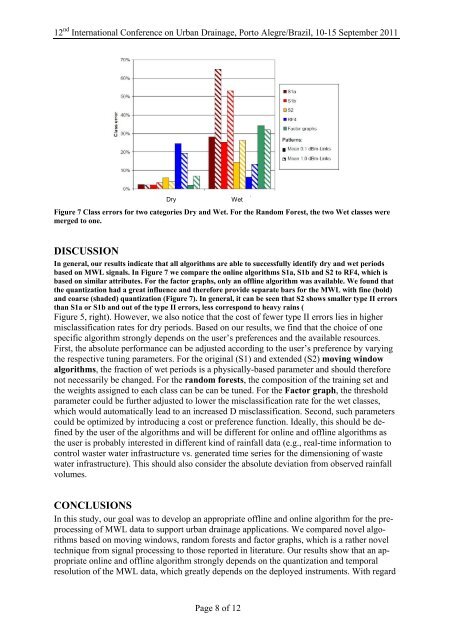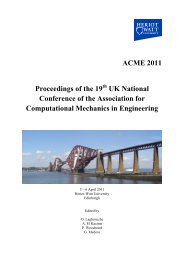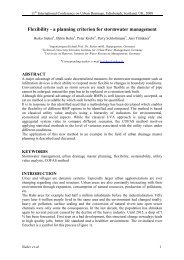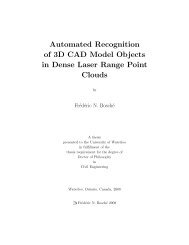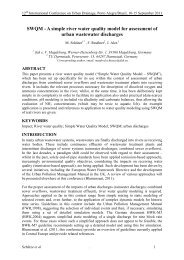Identification of dry and rainy periods using telecommunication ...
Identification of dry and rainy periods using telecommunication ...
Identification of dry and rainy periods using telecommunication ...
You also want an ePaper? Increase the reach of your titles
YUMPU automatically turns print PDFs into web optimized ePapers that Google loves.
12 nd International Conference on Urban Drainage, Porto Alegre/Brazil, 10-15 September 2011<br />
Dry Wet<br />
Figure 7 Class errors for two categories Dry <strong>and</strong> Wet. For the R<strong>and</strong>om Forest, the two Wet classes were<br />
merged to one.<br />
DISCUSSION<br />
In general, our results indicate that all algorithms are able to successfully identify <strong>dry</strong> <strong>and</strong> wet <strong>periods</strong><br />
based on MWL signals. In Figure 7 we compare the online algorithms S1a, S1b <strong>and</strong> S2 to RF4, which is<br />
based on similar attributes. For the factor graphs, only an <strong>of</strong>fline algorithm was available. We found that<br />
the quantization had a great influence <strong>and</strong> therefore provide separate bars for the MWL with fine (bold)<br />
<strong>and</strong> coarse (shaded) quantization (Figure 7). In general, it can be seen that S2 shows smaller type II errors<br />
than S1a or S1b <strong>and</strong> out <strong>of</strong> the type II errors, less correspond to heavy rains (<br />
Figure 5, right). However, we also notice that the cost <strong>of</strong> fewer type II errors lies in higher<br />
misclassification rates for <strong>dry</strong> <strong>periods</strong>. Based on our results, we find that the choice <strong>of</strong> one<br />
specific algorithm strongly depends on the user’s preferences <strong>and</strong> the available resources.<br />
First, the absolute performance can be adjusted according to the user’s preference by varying<br />
the respective tuning parameters. For the original (S1) <strong>and</strong> extended (S2) moving window<br />
algorithms, the fraction <strong>of</strong> wet <strong>periods</strong> is a physically-based parameter <strong>and</strong> should therefore<br />
not necessarily be changed. For the r<strong>and</strong>om forests, the composition <strong>of</strong> the training set <strong>and</strong><br />
the weights assigned to each class can be can be tuned. For the Factor graph, the threshold<br />
parameter could be further adjusted to lower the misclassification rate for the wet classes,<br />
which would automatically lead to an increased D misclassification. Second, such parameters<br />
could be optimized by introducing a cost or preference function. Ideally, this should be defined<br />
by the user <strong>of</strong> the algorithms <strong>and</strong> will be different for online <strong>and</strong> <strong>of</strong>fline algorithms as<br />
the user is probably interested in different kind <strong>of</strong> rainfall data (e.g., real-time information to<br />
control waster water infrastructure vs. generated time series for the dimensioning <strong>of</strong> waste<br />
water infrastructure). This should also consider the absolute deviation from observed rainfall<br />
volumes.<br />
CONCLUSIONS<br />
In this study, our goal was to develop an appropriate <strong>of</strong>fline <strong>and</strong> online algorithm for the preprocessing<br />
<strong>of</strong> MWL data to support urban drainage applications. We compared novel algorithms<br />
based on moving windows, r<strong>and</strong>om forests <strong>and</strong> factor graphs, which is a rather novel<br />
technique from signal processing to those reported in literature. Our results show that an appropriate<br />
online <strong>and</strong> <strong>of</strong>fline algorithm strongly depends on the quantization <strong>and</strong> temporal<br />
resolution <strong>of</strong> the MWL data, which greatly depends on the deployed instruments. With regard<br />
Page 8 <strong>of</strong> 12


